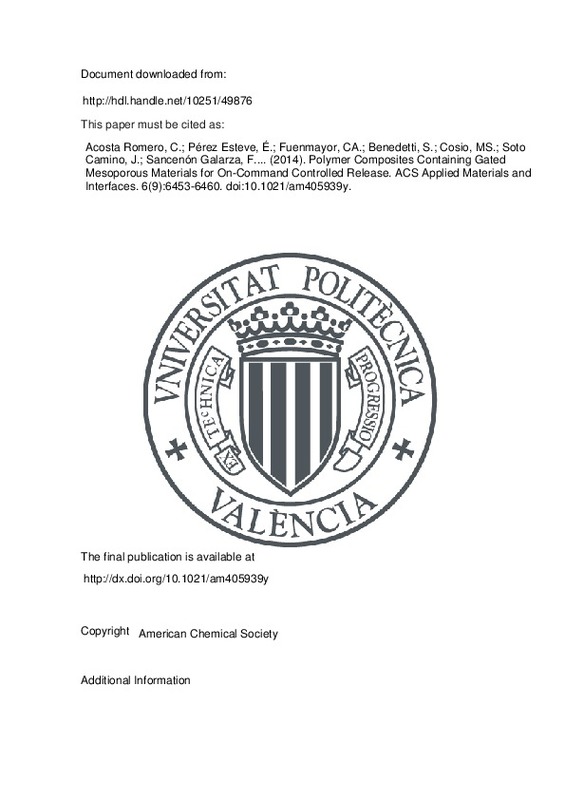Acosta Romero, C.; Pérez Esteve, E.; Fuenmayor, CA.; Benedetti, S.; Cosio, MS.; Soto Camino, J.; Sancenón Galarza, F.... (2014). Polymer Composites Containing Gated Mesoporous Materials for On-Command Controlled Release. ACS Applied Materials and Interfaces. 6(9):6453-6460. https://doi.org/10.1021/am405939y
Por favor, use este identificador para citar o enlazar este ítem: http://hdl.handle.net/10251/49876
|
Título:
|
Polymer Composites Containing Gated Mesoporous Materials for On-Command Controlled Release
|
|
Autor:
|
Acosta Romero, Carolina

 Pérez Esteve, Edgar
Fuenmayor, Carlos A.
Benedetti, Simona
Cosio, Maria Stella
Pérez Esteve, Edgar
Fuenmayor, Carlos A.
Benedetti, Simona
Cosio, Maria Stella

 Soto Camino, Juan
Soto Camino, Juan

 Sancenón Galarza, Félix
Mannino, Saverio
Sancenón Galarza, Félix
Mannino, Saverio

 Barat Baviera, José Manuel
Barat Baviera, José Manuel

 Marcos Martínez, María Dolores
Marcos Martínez, María Dolores

 Martínez Mañez, Ramón
Martínez Mañez, Ramón
|
|
Entidad UPV:
|
Universitat Politècnica de València. Departamento de Tecnología de Alimentos - Departament de Tecnologia d'Aliments
Universitat Politècnica de València. Departamento de Química - Departament de Química
|
|
Fecha difusión:
|
|
|
Resumen:
|
Polyamidic nanofibrous membranes containing gated silica mesoporous particles, acting as carriers, are described as novel hybrid composite materials for encapsulation and on-command delivery of garlic extracts. The carrier ...[+]
Polyamidic nanofibrous membranes containing gated silica mesoporous particles, acting as carriers, are described as novel hybrid composite materials for encapsulation and on-command delivery of garlic extracts. The carrier system consists of MCM-41 solids functionalized in the outer surface, with linear polyamines (solid P1) and with hydrolyzed starch (solid P2), both acting as molecular gates. Those particles were adsorbed on electospun nylon-6 nanofibrous membranes yielding to composite materials M1 and M2. FE-SEM analysis confirmed the presence of particles incorporated on the nylon nanofibers. The release of the entrapped molecules (garlic extract) from the P1, P2, M1, and M2 materials was evaluated using cyclic voltammetry measurements. Electrochemical studies showed that at acidic pH P1 and M1 were unable to release their entrapped cargo (closed gate), whereas at neutral pH both materials release their loading (open gate). Dealing with P2 and M2 materials, in the absence of pancreatin a negligible release is observed (closed gate), whereas in the presence of enzyme the load is freely to diffuse to the solution. These newly developed composite nanomaterials, provide a homogeneous easy-to-handle system with controlled delivery and bioactive-protective features, having potential applications on pharmacology, medical and engineering fields.
[-]
|
|
Palabras clave:
|
Composites
,
On-command delivery
,
Mesoporous
,
Electrospun nanofibers
,
Hybrid material.
|
|
Derechos de uso:
|
Reserva de todos los derechos
|
|
Fuente:
|
ACS Applied Materials and Interfaces. (issn:
1944-8244
)
|
|
DOI:
|
10.1021/am405939y
|
|
Editorial:
|
American Chemical Society
|
|
Versión del editor:
|
http://dx.doi.org/10.1021/am405939y
|
|
Código del Proyecto:
|
info:eu-repo/grantAgreement/GVA//GRISOLIA%2F2011%2F012/
info:eu-repo/grantAgreement/Generalitat Valenciana//PROMETEO09%2F2009%2F016/ES/Ayuda prometeo 2009 para el grupo de diseño y desarrollo de sensores/
info:eu-repo/grantAgreement/MINECO//AGL2012-39597-C02-01/ES/MEJORA DE LA ESTABILIDAD Y CONTROL DE LA VELOCIDAD DE LIBERACION DE BIOMOLECULAS MEDIANTE EL EMPLEO DE MICROCAPSULAS FUNCIONALIZADAS CON PUERTAS MOLECULARES/
info:eu-repo/grantAgreement/MINECO//AGL2012-39597-C02-02/ES/MICROPORTADORES INTELIGENTES PARA LA LIBERACION CONTROLADA DE SUSTANCIAS DE INTERES ALIMENTARIO./
info:eu-repo/grantAgreement/MINECO//MAT2012-38429-C04-01/ES/DESARROLLO DE MATERIALES FUNCIONALIZADOS CON PUERTAS NANOSCOPICAS PARA APLICACIONES DE LIBERACION CONTROLADA Y SENSORES PARA LA DETECCION DE NITRATO AMONICO, SULFIDRICO Y CO/
|
|
Agradecimientos:
|
The authors wish to express their gratitude to the Generalitat Valenciana (Grisolia scholarship 2011/012, project PROM-ETEO/2009/016), Spanish Government (MINECO Projects AGL2012-39597-C02-01, AGL2012-39597-C02-02 and ...[+]
The authors wish to express their gratitude to the Generalitat Valenciana (Grisolia scholarship 2011/012, project PROM-ETEO/2009/016), Spanish Government (MINECO Projects AGL2012-39597-C02-01, AGL2012-39597-C02-02 and MAT2012-38429-C04-01) and the CIBER-BBN for their support. IILA thanks DISTAM and Universita degli di Milano for a specialization scholarship. We would also like to thank the Institut de Ciencia dels Materials (ICMUV) and to the Microscopy Service of the Universitat Politecnica de Valencia for technical support. We thank Roquette for the Glucidex samples.
[-]
|
|
Tipo:
|
Artículo
|







![[Cerrado]](/themes/UPV/images/candado.png)


